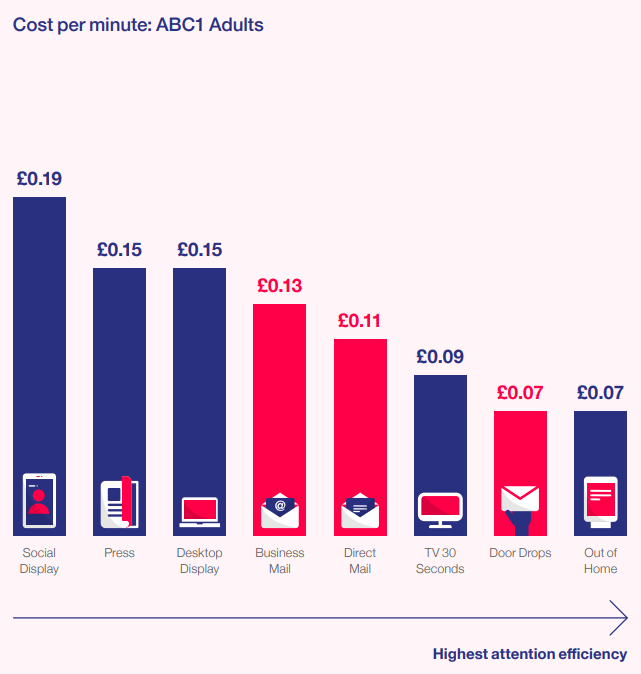Media Owner Research Needs a Large Pinch of Salt
Every major advertising channel has its own marketing body. In the UK, commerical TV has Thinkbox, commercial radio has Radiocentre and web ads have the IAB.
One of the things these organisations do to try to influence advertisers to spend money with their members is release pieces of public research. Full disclosure, I have a job in TV, have previously worked for large media agencies and I’ve carried out these types of studies. They can be really interesting to work on and often contain very useful insights.
They also need to be taken with a large pinch of salt. Any research from a vested-interest group deserves extra scepticism and I include my own work in that. Ask yourself if the results make sense and ask difficult questions of the authors.
One thing that you really need to watch for is these pieces of research being adopted into new presentations and losing their link to the original source, which might cause your guard to drop. The ideal result for a trade body releasing a piece of research about their own media channel is to have its positive results adopted as established fact by the marketing industry, and for their chart to pop up all over the place, without being flagged as a media owner funded study.
Always check footnotes and ask, “where did these numbers come from?”.
These points came to mind today because I saw a piece of research by JICMAIL about the costs of attention for different media channels. Attention is a hot measurement topic at the moment – moving beyond measuring whether an ad was simply delivered to somebody and trying to account for whether they actually paid attention to it.
Here’s the key chart.

Blimey! Direct mail rivals 30″ TV spots for cost per minute of attention. Door drops come in ahead of telly.
Hang on though. Isn’t direct mail expensive? TV can be pretty expensive but it’s not putting an actual, physical envelope in your hand, delivered by the postie levels of expensive.
Sceptical hat on and grab your calculator. This won’t take long, I promise.
First up, the chart says ABC1 adults (i.e. higher income adults). We’re not going to use those, we’re going to use all adults because it’s a fairer comparison.
Why?
What’s the cost of mailing one letter to me, the author of this post? A first class stamp costs £1.25.
What’s the cost of showing me a TV ad? It’s a heck of a lot more than £1.25 because loads of other people will see that ad too. You can’t send just me a TV ad so of course it’s cheaper to send me a letter. The same happens when you target ABC1 adults on TV – loads of other people see the ad too (and those other views are free).
So we’re not going to use ABC1 adults, we’re going to use all adults – everyone who sees the ads – because it puts both channels on a level playing field.
I’m going to compare the TV and Direct Mail columns, which present TV and DM as having quite similar costs per minute of attention.
Calculator time…
TV ads cost about £12 per thousand adult views. They can be much less, down to about 1/3 of that cost but let’s go with £12 anyway. We don’t need TV to be cheap for this example to work.
£12 per thousand is 1.2p per view.
Direct mail costs 32p a letter.
Also, you only pay for TV ad views if there’s somebody in the room but not all of those direct mail letters will be opened, so we should account for an opening rate. One page says it’s 73%, another says it’s 60% opened with 40% actually being read. Let’s run with a guesstimate of 50% of direct mail gets opened and at least glanced at, rather than immediately binned once the recipient realises what it is.
A 50% read rate feels pretty generous to me but you’ve got your calculator now, if you think it’s higher, run with your own number. Use 100% if you like, it won’t make much difference to the end result.
After accounting for opening & read rate, DM costs 64p a contact vs. 1.2p for TV. That’s an awfully big gap but let’s see if attention can close it.
30 second TV ads are 30 seconds long.
And we just saw that direct mail costs 64p/1.2p = 53x as much per contact as TV.
Which means each piece of direct mail that actually gets read needs to be read for 26.5 minutes to bridge the cost gap.
Hmmmm. Do you read direct mail letters for 26.5 minutes each?
Even JICMAIL don’t think people read direct mail for 26.5 minutes. They say 108 seconds.
Attention is not bridging that cost gap.
Calculators down, that’s the end of the maths. If you track down the original version of the chart, it has footnotes about eye tracking, time diaries and verification by video analytics. I could take issue with the technicalities of the study’s methodology but there’s no need – it simply can’t be accurate. You can knock it over with a calculator in less time than it takes the average person to read a piece of direct mail.
Bring a pinch of salt to your reading of charts published by vested interest groups. A large one.
JICMAIL have written a reply to this post. As their title says, “You Do the Math” and I’d strongly recommend plugging in your own costs, data and assumptions about effectiveness for all media channels to see where you end up. I stand by the calculations above.